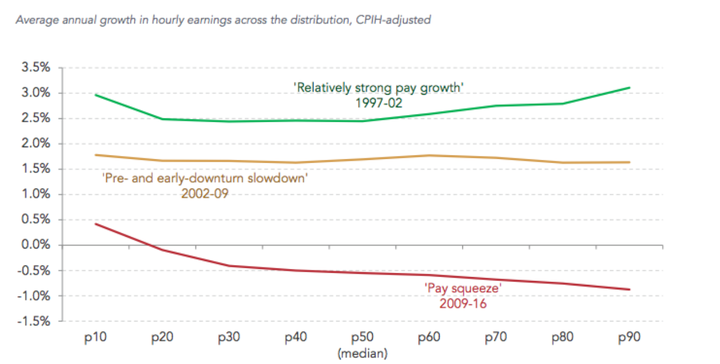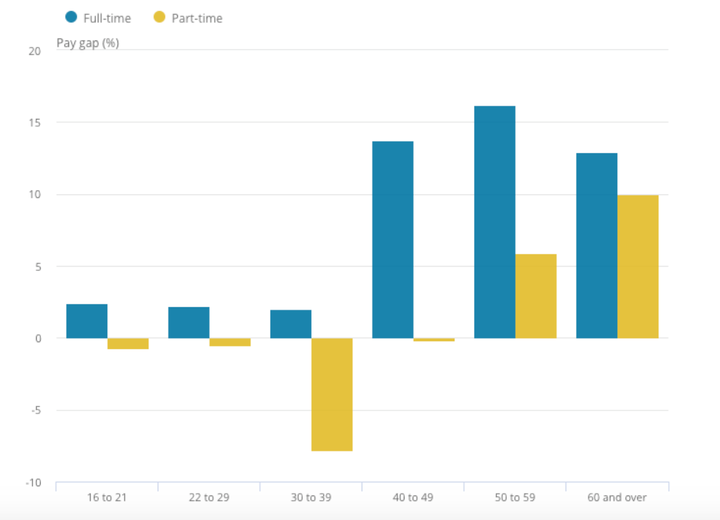
Why do you go to work? If you’re lucky, you might say because you love it, because it challenges you, because you want to contribute to society. But what most of us will really say is this: I go to work to make a living.
No discussion of our working lives is complete without an examination of what’s happening with pay – and for those working in the UK, there has been very little good news on that front in more than a decade: overall, wages are still lower than they were before the 2008 financial crisis.
This, though, masks big differences in the patterns of what’s going on with pay for different people – and the overall picture spells particularly bad news for millennials who entered the workforce during this decade of crisis. To show why this is so, we’ll tackle different parts of the issue in turn, before bringing things together.
The big picture
The core problem for the UK workforce is that since 2008 – on average – prices have gone up faster than wages have. This situation, where inflation might over around 2% to 3%, but wages only go up 1% to 2% (if at all) is referred to as a loss in “real terms” – the figure on your payslip might have gone up a few pounds, but it goes less far than it used to.
According to analysis by the respect Institute for Fiscal Studies, the average earnings of a UK worker are still considerably below their pre-crisis level, and are expected by the IFS to remain so for several years to come – they think the country will likely have gone around 15 years without a pay rise before they resume.
This is a result of the UK’s sluggish economic recovery from the crisis, and the end of productivity growth: it used to be that the UK got better at producing more goods and services for each hour worked, year-by-year, but this is no longer the case. The relative collapse of union membership is likely to also have an effect keeping wages down.
This does not mean every worker is affected equally, of course. Some workers will have been promoted several times over the decade, or work in careers which still had good salary growth. There’s some evidence to suggest who won and who lost.

Who’s been hit hardest
Speaking in general terms, the Resolution Foundation – which has done extensive research into pay and work – has found that the 2009-2016 pay squeeze has affected younger workers, men, and full-time workers more than older and part-time workers – and unusually, thanks to increases in the minimum and living wages, the lowest-paid have been slightly less hit by the wage freeze than others. Indeed, the very poorest 10% were the only group to see any increase in hourly earnings during that period.

However, it’s important to note this group are often heavily hit by the freeze in in-work benefits and had less ability to withstand hits to their income than their richer counterparts.
These averages mask huge differences in different professions, though: some those experiencing shortages in hiring skilled workers have seen sizeable pay increases, while many others – particularly in the public sector – have experienced sizeable cuts to their pay.
Analysis by the BBC of five years’ of official pay data last year revealed a slew of mainly skilled professions had seen good pay rises over the five years studied. Air traffic controllers were up 54%, electronics engineers 35%, tailors and dressmakers 31% and energy plant operatives up 29%.
By contrast, the public sector pay freeze, coupled with changes to the promotion structure saw probation officers become the hardest hit profession, with real terms earnings down 20%. School inspectors took a hit of 11%, shelf fillers were hit with a 10% cut, and museum curators and archivists 9%.
In the world of wages, averages only take you so far: a lot of what happens not just in terms of level of earnings, but whether or not they keep pace with inflation, depends on the sector you work in – and on your gender.

Age and the gender pay gap
The official measure of the UK’s gender pay gap puts the difference in hourly earnings between men and women at around 20%, down from around 30% a few decades ago – but the reasons for it shrinking are not especially reassuring.
The shrinking difference in hourly earnings does not appear to be because of a drop in, for example, the average pay gap between a graduate man and graduate woman shrinking – it isn’t – but rather because of a change in how women enter the workforce: more women are graduates, and more women work full-time than used to – both attract higher pay than the alternative, meaning the overall gap shrinks – even as it endures for individual women.
While the official data shows the gender pay gap exists at all ages in the work force, it also reveals that it gets far larger as women get older – particularly at the point where women, including those in highly skilled and well-paid jobs either leave the work force or go part-time to look after children. While some men do the same, it is still disproportionately women who take on the role of primary caregiver to children.

These effects become starkly apparent in the above breakdown of full- and part-time wage gaps by age, published by the Office for National Statistics. Women in their teens, 20s and 30s working full time earn slightly – but not much – less than their male counterparts.
Then, for women in their 30s, there is a huge surge in the part-time pay gap in favour of women – explained by a number of highly-skilled women who have children returning to the workforce in part-time roles. By their 40s, the effects of years away from the full-time workforce are exacerbated, leading to surging pay gaps.
This is by no means to say having children is the only factor in the pay gap – the data says otherwise – but it is a major one, and this is an issue for “older millennial” women, now in their early-to-mid 30s, who may find they have seen the bulk of the pay rises they will ever get.
What you earn in your 20s matters more than you think
Any graduate who hasn’t gone straight into a high-end city job knows that your first salary comes as a bit of a nasty shock: many of us end up looking on the amount of spare cash we had as a student, even, with envy.
But generally, if things go to plan, you get promoted – or hop jobs – several times in your 20s, and end up with something that might not be the salary of your dreams, but is something much easier to get by on than what you earned at 22.
This is confirmed by a huge piece of research conducted by the Federal Reserve Bank of New York, using more than five million people’s earnings data. It found, in short, that the bulk of the pay rises you will get for your whole career come in your first 10 years of work – and that most people’s earning then stagnate for the following two decades. In short, whether you’re going to be an average, good, or meteoric earner, most of where you’ll end up will be decided in your first 10 years in the workforce.
That’s not good news for most millennial workers. For one, many older millennials struggled to find a first job as they graduated right into the financial crisis – some even saw lucrative graduate job offers withdrawn under their noses. During the crisis, the youth employment rate fell 4%, while for older workers it remained largely unchanged.
Those who got jobs saw an end to the tradition of a 3% to 5% annual pay bump just for staying in the job, and struggled to find promotions as older workers stayed put – and contrary to the job-hopping perception of millennials, this group was less likely to leave for other jobs.

The chart above, from the Resolution Foundation, makes this effect clear – there was a sharp drop in job-to-job moves during the crisis, which is subsequently beginning to recover. Research shows job moves lead to higher overall earnings, and so are an important factor in establishing long-term life earnings.
What it all means
The short answer to all of the above is that millennials picked a terrible era to enter the workforce: lower employment rates, stagnant earnings, and difficulty in job hopping mean that this age group has been hardest hit by the UK’s “lost decade” – and the highest quality research on pay suggests this will have life-long effects, all of which will be compounded for women at work.
It also suggests that this group has a good case to make for being disproportionately affected by a crisis it had no part in making – perhaps a good lobbying point for its advocates, especially as older adults receive better protections and spending from the state through measures like the pensions “triple lock”. Far from being an entitled generation of “snowflakes”, millennials are really having to work for their money.
• James Ball is a HuffPost UK columnist.
We spend more and more of our lives at work, but wages are stagnating, the workplace is getting more competitive and it’s impacted by nearly every other change in society: from Brexit to inequality to when we decide to have babies.
How We Work Now takes a comprehensive and deep dive into the working lives of our readers with exposes, experiences and evidence to help people navigate their careers from the very first rung on the ladder.
